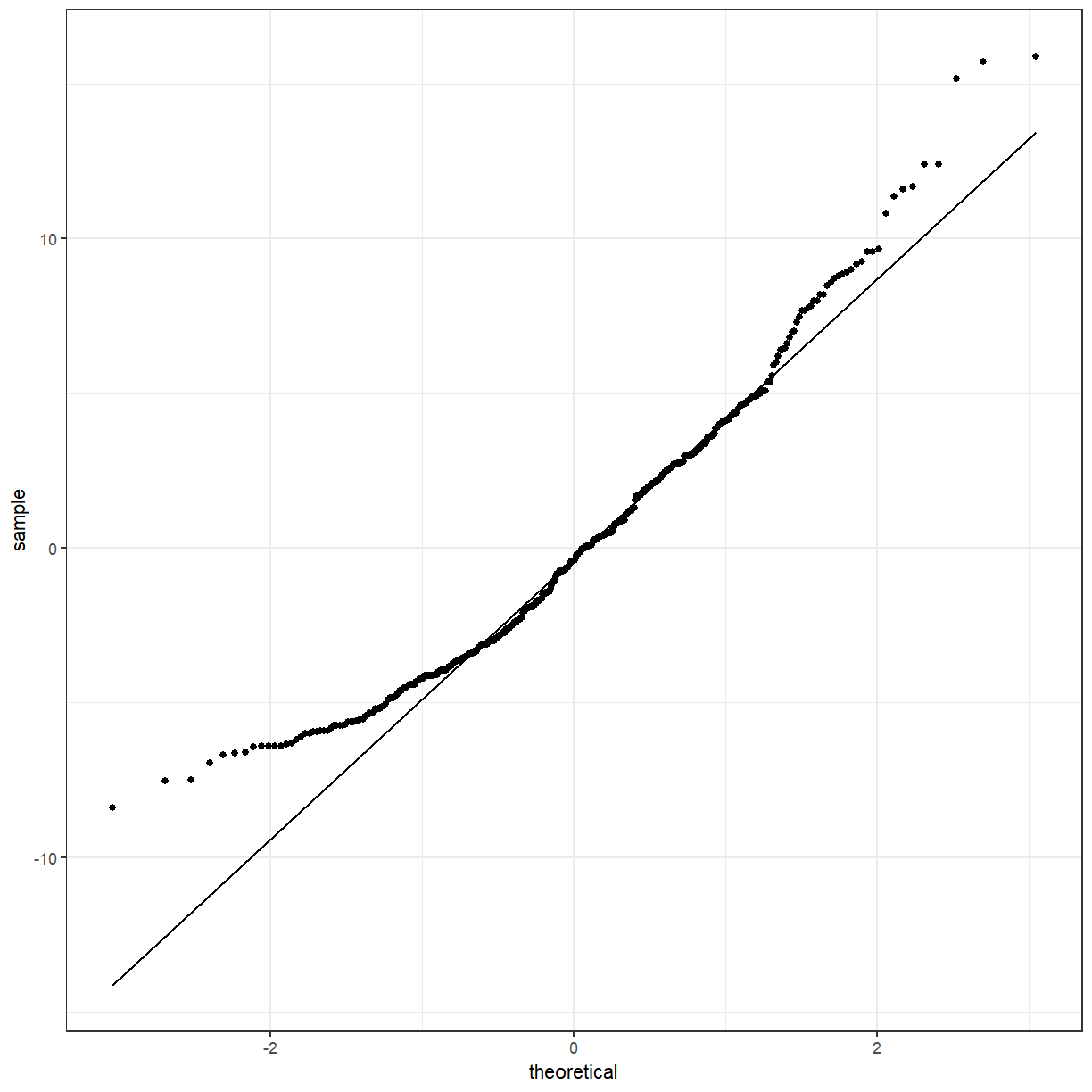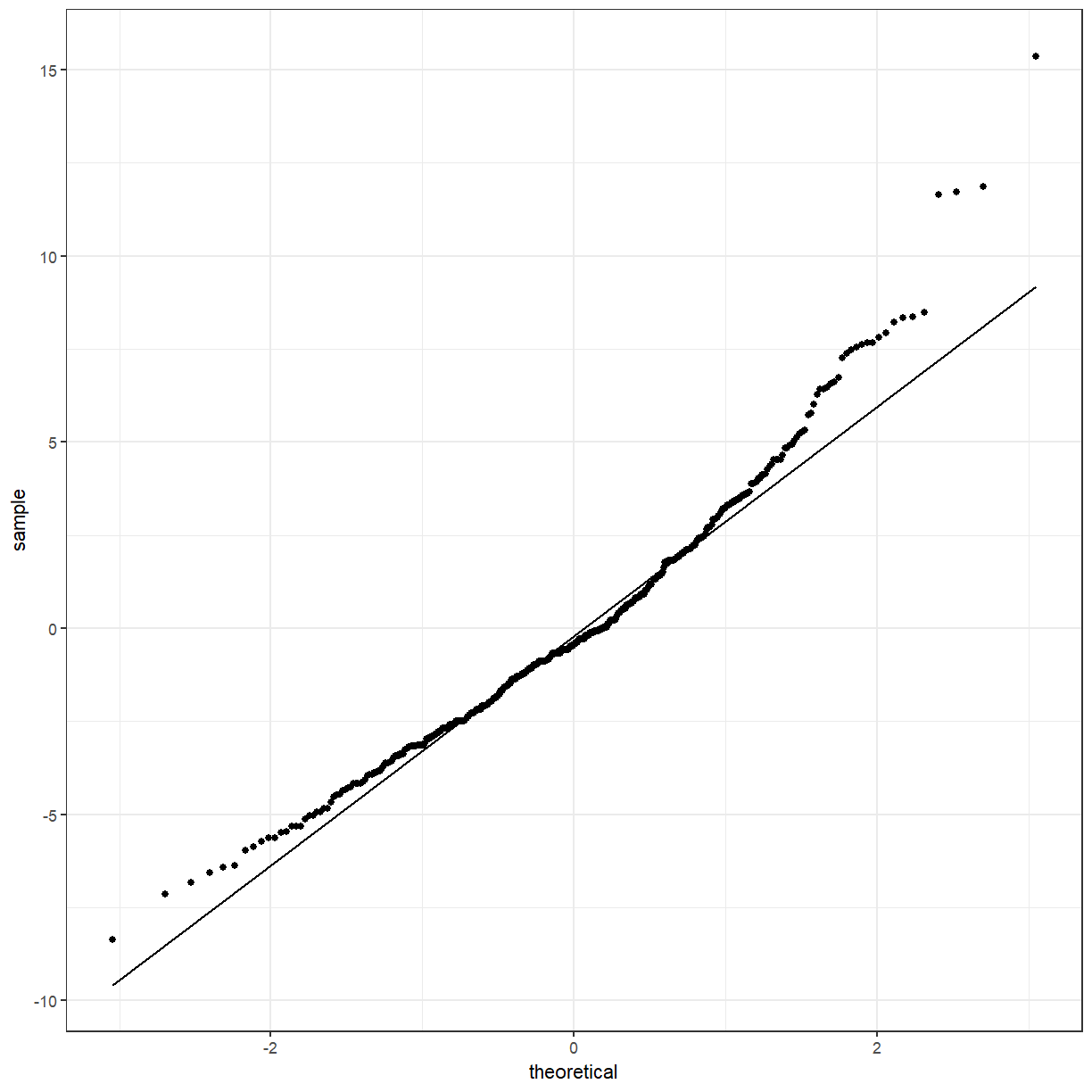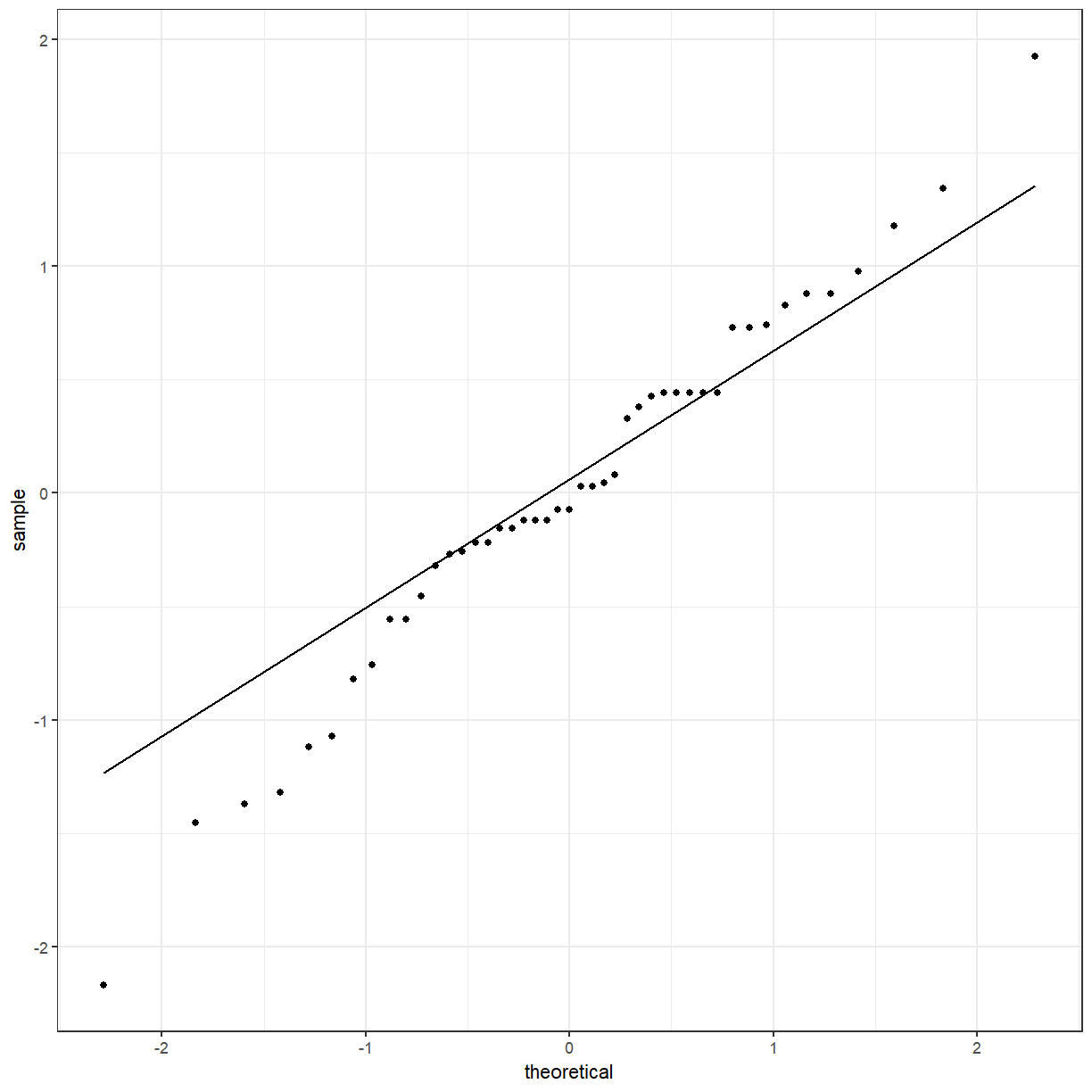Testing differences in categories
Overview
Teaching: 60 min
Exercises: 30 minQuestions
Choose the appropriate test for the data you have.
Numeric summaries of groups
In the previous lesson we looked at some visualisations of the data that suggested that there might be differences between some of the groups, but we would like to test this.
To start, we might want to look at the different groups in numbers. We can use one of the
tidyverse packages, dplyr, to calculate these numbers.
library(tidyverse)
pattani %>%
summarise(mean = mean(blood_lead), sd = sd(blood_lead))
# A tibble: 1 x 2
mean sd
<dbl> <dbl>
1 NA NaN
We don’t get any results! Remember that the blood_lead variable had some missing values. By
default, the functions mean and sd will not give you a result if the input has missing
values. We can ask the functions to ignore them by using the argument na.rm = TRUE.
pattani %>%
summarise(mean = mean(blood_lead, na.rm = TRUE), sd = sd(blood_lead, na.rm = TRUE))
# A tibble: 1 x 2
mean sd
<dbl> <dbl>
1 12.0 4.34
Naming the arguments in
summariseIt isn’t necessary to name the arguments in
summarisebut it makes the output neater.
These give us the mean and standard deviation for the entire variable, but we want to split
that up by some other variables. For this we will use the group_by function.
pattani %>%
group_by(gender) %>%
summarise(mean = mean(blood_lead, na.rm = TRUE), sd = sd(blood_lead, na.rm = TRUE))
# A tibble: 2 x 3
gender mean sd
<fct> <dbl> <dbl>
1 Boy 12.4 4.57
2 Girl 11.7 4.11
Or by school:
pattani %>%
group_by(school) %>%
summarise(mean = mean(blood_lead, na.rm = TRUE), sd = sd(blood_lead, na.rm = TRUE))
# A tibble: 5 x 3
school mean sd
<fct> <dbl> <dbl>
1 Tangkadeng 8.48 2.31
2 Thamthalu 16.5 4.32
3 Tachi 12.9 4.03
4 Tesabal 3 15.2 3.32
5 Sabarang 11.6 2.92
You can also do both:
pattani %>%
group_by(gender, school) %>%
summarise(mean = mean(blood_lead, na.rm = TRUE), sd = sd(blood_lead, na.rm = TRUE))
# A tibble: 10 x 4
# Groups: gender [2]
gender school mean sd
<fct> <fct> <dbl> <dbl>
1 Boy Tangkadeng 8.72 2.24
2 Boy Thamthalu 17.6 4.66
3 Boy Tachi 13.4 4.18
4 Boy Tesabal 3 15.3 2.60
5 Boy Sabarang 11.7 3.07
6 Girl Tangkadeng 8.22 2.38
7 Girl Thamthalu 14.8 3.25
8 Girl Tachi 12.6 3.92
9 Girl Tesabal 3 15.1 3.95
10 Girl Sabarang 11.5 2.87
Cuckoo egg lengths
Find the mean and standard deviation for the cuckoo eggs by host nest type.
Solution
cuckoo %>% group_by(Nest) %>% summarise(mean = mean(Length), sd = sd(Length))# A tibble: 3 x 3 Nest mean sd <fct> <dbl> <dbl> 1 Robin 22.6 0.682 2 Wren 21.1 0.754 3 Sparrow 23.1 1.02We don’t have to use
na.rm = TRUEbecause there aren’t any missing values.
Testing the difference between 2 groups
Going back to the difference by gender,
pattani %>%
group_by(gender) %>%
summarise(mean = mean(blood_lead, na.rm = TRUE), sd = sd(blood_lead, na.rm = TRUE))
# A tibble: 2 x 3
gender mean sd
<fct> <dbl> <dbl>
1 Boy 12.4 4.57
2 Girl 11.7 4.11
We can see that the means of the boys are similar to the means of the girls, but we would like
to formally test if they are statistically different from each other. One way to do this is
with a t test, using the R function t.test.
The question we are asking is Is the mean blood lead level for the boys different to the mean blood lead level for the girls? Formally, we could say:
t.test(blood_lead ~ gender, data = pattani)
Welch Two Sample t-test
data: blood_lead by gender
t = 1.5858, df = 410.97, p-value = 0.1136
alternative hypothesis: true difference in means is not equal to 0
95 percent confidence interval:
-0.1594838 1.4905952
sample estimates:
mean in group Boy mean in group Girl
12.40049 11.73493
Notice that the means shown for each group are the same as what we calculated earlier. The alternative hypothesis is that the difference in means is not equal to 0, as we mentioned. The p-value is 0.1136. This indicates that the the mean blood lead level for the boys and girls is not significantly different at the 0.05 level. The 95% confidence interval includes 0, which is another way to see that the means are not different from each other.
Analysis of Variance (ANOVA)
A t test can only be used when you have 2 groups, like boys and girls, so we need to use
a different technique when you have more than 2 groups, like the 5 schools. This is the
analysis of variance or ANOVA. The main R function to perform this analysis is
aov. Be aware that there is also a function anova although this is used after you have
fit the model using aov.
One-way anova is a statistical technique that can be used to investigate the effect of a single categorical predictor variable on a continuous response variable. The effect is measured by looking at the values from different groups and comparing the averages. Of course, in any such situation there will be variability. If the variability within each group is noticeably less than the variability between the groups, then we decide that there are significant differences between the groups.
One-way anova generalises the two-sample t test. You can think of the two-sample t test as comparing the values from two groups. Alternatively, you can think of it as seeing whether the grouping variable has an effect on the response variable (and so here we can look at grouping variables with 3, 4 or more values).
You can still use ANOVAs for 2 groups:
gender_aov <- aov(blood_lead ~ gender, data = pattani)
gender_aov
Call:
aov(formula = blood_lead ~ gender, data = pattani)
Terms:
gender Residuals
Sum of Squares 47.791 8091.610
Deg. of Freedom 1 431
Residual standard error: 4.332902
Estimated effects may be unbalanced
1 observation deleted due to missingness
This give us some information, but there are some other things that we might like to know,
like the p-value. Previously we used the summary function to get a summary of the data.
We can also use it to get a summary of an ANOVA object.
summary(gender_aov)
Df Sum Sq Mean Sq F value Pr(>F)
gender 1 48 47.79 2.546 0.111
Residuals 431 8092 18.77
1 observation deleted due to missingness
Actually not that useful. But ANOVAs are a special type of linear model (which we will talk
about in more detail tomorrow) so we can directly call the summary.lm function which deals
with linear models.
summary.lm(gender_aov)
Call:
aov(formula = blood_lead ~ gender, data = pattani)
Residuals:
Min 1Q Median 3Q Max
-8.4005 -3.4005 -0.4005 2.6995 15.8995
Coefficients:
Estimate Std. Error t value Pr(>|t|)
(Intercept) 12.4005 0.3034 40.877 <2e-16 ***
genderGirl -0.6656 0.4171 -1.595 0.111
---
Signif. codes: 0 '***' 0.001 '**' 0.01 '*' 0.05 '.' 0.1 ' ' 1
Residual standard error: 4.333 on 431 degrees of freedom
(1 observation deleted due to missingness)
Multiple R-squared: 0.005872, Adjusted R-squared: 0.003565
F-statistic: 2.546 on 1 and 431 DF, p-value: 0.1113
Now we can see the p-value and several other pieces of information about the fitted model.
Looking at the line for the gender variable, you can see that the p-value is
0.1113,
which is equivalent to the p-value from the t test.
It is slightly different from the previous p-value because the standard
t test makes slightly different assumptions from the ANOVA. We can get them to match by
using the var.equal = TRUE argument to t.test.
t.test(blood_lead ~ gender, data = pattani, var.equal = TRUE)
Two Sample t-test
data: blood_lead by gender
t = 1.5955, df = 431, p-value = 0.1113
alternative hypothesis: true difference in means is not equal to 0
95 percent confidence interval:
-0.1543414 1.4854528
sample estimates:
mean in group Boy mean in group Girl
12.40049 11.73493
We should check if the model fit well. To do this we will need to get some of the parameters
from the fitted model. The augment function in the broom package helps with this.
gender_aov_augment <- broom::augment(gender_aov, pattani)
gender_aov_augment
# A tibble: 433 x 15
ID blood_lead age gender school duration water ln_blood_lead
<dbl> <dbl> <dbl> <fct> <fct> <dbl> <fct> <dbl>
1 1 11.7 13 Boy Tangk~ 13 Boil 2.46
2 2 11.8 13 Boy Tangk~ 5 Boil 2.47
3 3 6.4 13 Girl Tangk~ 13 Stand 1.86
4 4 6.9 11 Girl Tangk~ 11 Boil 1.93
5 5 10.3 13 Girl Tangk~ 5 Boil 2.33
6 6 8.3 13 Girl Tangk~ 13 Filt~ 2.12
7 7 6.2 13 Girl Tangk~ 5 Filt~ 1.82
8 8 9.4 13 Boy Tangk~ 13 Stand 2.24
9 9 14.9 11 Boy Tangk~ 11 Boil 2.70
10 10 8.1 11 Girl Tangk~ 11 Filt~ 2.09
# ... with 423 more rows, and 7 more variables: .fitted <dbl>,
# .se.fit <dbl>, .resid <dbl>, .hat <dbl>, .sigma <dbl>, .cooksd <dbl>,
# .std.resid <dbl>
One of the assumptions of the ANOVA model is that the residuals are Normally distributed. Like before, we can use a QQ plot to check for normality.
ggplot(gender_aov_augment, aes(sample = .resid)) +
geom_qq() +
geom_qq_line()

The points deviate from the line, so the residuals are probably not normally distributed. Something to consider, but we will move on with the model.
ANOVA with more than 2 groups
We have used ANOVA on a variable with 2 groups, which we could have done with a t test, but now we should use it on a variable with more than 2 groups.
school_aov <- aov(blood_lead ~ school, data = pattani)
summary.lm(school_aov)
Call:
aov(formula = blood_lead ~ school, data = pattani)
Residuals:
Min 1Q Median 3Q Max
-8.3652 -2.2844 -0.4312 1.8688 15.3688
Coefficients:
Estimate Std. Error t value Pr(>|t|)
(Intercept) 8.4844 0.2885 29.413 < 2e-16 ***
schoolThamthalu 7.9808 0.5722 13.948 < 2e-16 ***
schoolTachi 4.4468 0.4135 10.755 < 2e-16 ***
schoolTesabal 3 6.6914 0.5142 13.014 < 2e-16 ***
schoolSabarang 3.0978 0.5142 6.025 3.65e-09 ***
---
Signif. codes: 0 '***' 0.001 '**' 0.01 '*' 0.05 '.' 0.1 ' ' 1
Residual standard error: 3.352 on 428 degrees of freedom
(1 observation deleted due to missingness)
Multiple R-squared: 0.4093, Adjusted R-squared: 0.4038
F-statistic: 74.15 on 4 and 428 DF, p-value: < 2.2e-16
As a reminder, the names of the schools were Tangkadeng, Thamthalu, Tachi, Tesabal 3, Sabarang. Notice that the first school, Tangkadeng, does not appear in the summary output. The other schools are being compared with this school. The p-values of all the schools are less than 0.05, so they are all statistically different from the first school. The overall p-value is also less than 0.05.
Cuckoo egg lengths ANOVA
Perform an ANOVA on the cuckoo data.
Solution
cuckoo_aov <- aov(Length ~ Nest, data = cuckoo) summary.lm(cuckoo_aov)Call: aov(formula = Length ~ Nest, data = cuckoo) Residuals: Min 1Q Median 3Q Max -2.17143 -0.32000 -0.07143 0.44375 1.92857 Coefficients: Estimate Std. Error t value Pr(>|t|) (Intercept) 22.5563 0.2061 109.468 < 2e-16 *** NestWren -1.4363 0.2962 -4.849 1.74e-05 *** NestSparrow 0.5152 0.3016 1.708 0.095 . --- Signif. codes: 0 '***' 0.001 '**' 0.01 '*' 0.05 '.' 0.1 ' ' 1 Residual standard error: 0.8242 on 42 degrees of freedom Multiple R-squared: 0.5133, Adjusted R-squared: 0.4901 F-statistic: 22.15 on 2 and 42 DF, p-value: 2.705e-07
Again, we should check the residuals to see if they are Normal.
school_aov_augment <- broom::augment(school_aov, pattani)
ggplot(school_aov_augment, aes(sample = .resid)) +
geom_qq() +
geom_qq_line()

They seem closer to normality than the model with gender, but still a small amount of concern.
Cuckoo ANOVA residuals
Check the residuals for the cuckoo ANOVA.
Solution
cuckoo_aov_augment <- broom::augment(cuckoo_aov, cuckoo) ggplot(cuckoo_aov_augment, aes(sample = .resid)) + geom_qq() + geom_qq_line()
ANOVA with 2 variables
So far we have only looked at models with 1 variable. You can extend the ANOVA model to look at multiple variables, for example both gender and school.
both_aov <- aov(blood_lead ~ gender * school, data = pattani)
summary.lm(both_aov)
Call:
aov(formula = blood_lead ~ gender * school, data = pattani)
Residuals:
Min 1Q Median 3Q Max
-9.5148 -2.2727 -0.4159 1.7806 14.9231
Coefficients:
Estimate Std. Error t value Pr(>|t|)
(Intercept) 8.7194 0.3926 22.210 < 2e-16 ***
genderGirl -0.5036 0.5747 -0.876 0.381405
schoolThamthalu 8.8954 0.7518 11.833 < 2e-16 ***
schoolTachi 4.6575 0.6063 7.682 1.1e-13 ***
schoolTesabal 3 6.5677 0.7156 9.177 < 2e-16 ***
schoolSabarang 2.9533 0.8115 3.639 0.000307 ***
genderGirl:schoolThamthalu -2.2797 1.1513 -1.980 0.048334 *
genderGirl:schoolTachi -0.2470 0.8305 -0.297 0.766264
genderGirl:schoolTesabal 3 0.2810 1.0229 0.275 0.783674
genderGirl:schoolSabarang 0.3633 1.0546 0.345 0.730615
---
Signif. codes: 0 '***' 0.001 '**' 0.01 '*' 0.05 '.' 0.1 ' ' 1
Residual standard error: 3.331 on 423 degrees of freedom
(1 observation deleted due to missingness)
Multiple R-squared: 0.4233, Adjusted R-squared: 0.411
F-statistic: 34.49 on 9 and 423 DF, p-value: < 2.2e-16
A note on nesting models
Another way of writing this model would be
aov(blood_lead ~ gender + school + gender:school, data = pattani)
The interaction term is not significant so we can run the model again without it.
both_aov2 <- aov(blood_lead ~ gender + school, data = pattani)
summary.lm(both_aov2)
Call:
aov(formula = blood_lead ~ gender + school, data = pattani)
Residuals:
Min 1Q Median 3Q Max
-8.6655 -2.3123 -0.4629 1.7763 14.9371
Coefficients:
Estimate Std. Error t value Pr(>|t|)
(Intercept) 8.8237 0.3247 27.173 < 2e-16 ***
genderGirl -0.7271 0.3251 -2.237 0.0258 *
schoolThamthalu 7.9418 0.5698 13.938 < 2e-16 ***
schoolTachi 4.5392 0.4136 10.974 < 2e-16 ***
schoolTesabal 3 6.7156 0.5119 13.119 < 2e-16 ***
schoolSabarang 3.2276 0.5151 6.266 9.04e-10 ***
---
Signif. codes: 0 '***' 0.001 '**' 0.01 '*' 0.05 '.' 0.1 ' ' 1
Residual standard error: 3.336 on 427 degrees of freedom
(1 observation deleted due to missingness)
Multiple R-squared: 0.4162, Adjusted R-squared: 0.4093
F-statistic: 60.88 on 5 and 427 DF, p-value: < 2.2e-16
We can compare these models with the anova function.
anova(school_aov, both_aov2, both_aov)
Analysis of Variance Table
Model 1: blood_lead ~ school
Model 2: blood_lead ~ gender + school
Model 3: blood_lead ~ gender * school
Res.Df RSS Df Sum of Sq F Pr(>F)
1 428 4807.6
2 427 4752.0 1 55.674 5.0168 0.02562 *
3 423 4694.3 4 57.678 1.2993 0.26953
---
Signif. codes: 0 '***' 0.001 '**' 0.01 '*' 0.05 '.' 0.1 ' ' 1
Thanks
Some of these notes are based on material in Moore, McCabe & Craig (2017), Peter Petocz’s lecture notes for STAT270, and Drew Allen’s Intro to Statistics in R workshop.
Key Points
You can use t tests and ANOVAs if you have a continuous response and categorical predictors.
